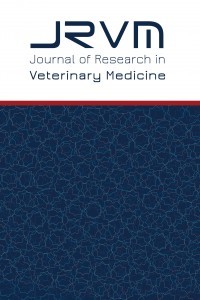Histological and Molecular Evaluation of Raw Meatball Products
Histological and Molecular Evaluation of Raw Meatball Products
Meat is an important source of protein with high biological value. Due to this importance, the production and consumption of meat and meat products such as minced meat, salami, sausage, meatballs and roasted meat has been increasing rapidly in recent years. In order to earn more money, some companies sell animal meats that are not consumed by the society by mixing them into meat products without considering the health, habits, ethical and cultural values of people. In this study, it is aimed to examine whether there are undesirable tissues and muscle tissue belonging to different species in meat products by making histological and molecular evaluations in raw meatball products offered for sale. Evaluations were made by taking samples of raw meatball products offered for sale by 6 different well known supermarkets. In the results we obtained, it was observed that the integrity of the muscle tissue was not impaired in sample 1, but the presence of cartilage fragments in places. In sample 2, different sizes of tendon fragments and nerve fiber bundles were detected, with less muscle tissue. In sample number 3, it was observed that the integrity of the muscle tissue was not impaired and the spice pieces were excessive. In sample number 4, it was observed that the integrity of the muscle tissue was partially damaged. In sample 5, large tendon fragments and abundant connective tissue were detected. In sample 6, an image was detected, suggesting that it was caused by too much use of the additive. In the RT-PCR results, no tissue belonging to different species was found in any of the 6 samples we received. These results, in addition to being inappropriate in terms of public health and consumer rights, also appear as attempts to gain unfair financial gain.
Keywords:
Raw meatball histology, Rt-Pcr.,
___
- 1. Schmid A. The Role of Meat Fat in the Human Diet. Crit Rev Food Sci Nutr. 2011; 51(1): 50 - 66.
- 2. Sağlam M, Aştı RN, Özer A. Genel Histoloji. Yorum Matbaa, Ankara. 2001.
- 3. McAfee AJ, McSorley EM, Cuskelly GJ, et al. Red meat consumption: An overview of the risks and benefits. Meat Sci. 2010; 84(1): 1 - 13.
- 4. Türk Gıda Kodeksi Et ve Et Ürünleri Tebliği. Tebliğ No: 2016/3, sayı 29603, Resmi Gazete. https://www.resmigazete.gov.tr/eskiler/2019/01/20190129-4.htm. Accessed July 21,2022.
- 5. Kırmızı Et Sanayicileri ve Üreticiler Birliği. https://www.etbir.org/. Accessed 21 April,2022.
- 6. İnce E, Özfiliz N. Türkiye’de Süpermarketlerde Satışa Sunulan Fermente ve Isıl İşlem Görmüş Sucukların Histolojik Muayene ile Kalitelerinin Belirlenmesi. J Res Vet Med. 2016; 35(1): 17 - 23.
- 7. Güçer L, Gövercin İ. Taklit veya Tağşiş Edilmiş Et ve Et Ürünlerinin Histolojik Muayenesi. Analiz’35. 2010; 5: 24 - 28.
- 8. Erdost H. Et Ürünlerinde histolojik analizin önemi. In: Hecer C, ed. Et ve Et Ürünleri. Türkiye Klinikleri; Ankara: 2021: 70-74.
- 9. Arslan A. Et Muayenesi ve Et Ürünleri Teknolojisi, 2th ed. Medipres, Elazığ; 2013.
- 10. Crossmon CA. Modification of Mallory’s connective tissue stain with a discussion of the principles involved. Anat Rec. 1937; 69: 33 - 38.
- 11. Atasever M, Çelik İ, Keleş A, et al. Histological determination of different tissues in Turkish fermented sausages. Eurasian J Vet Sci. 1999; 15: 147 - 154.
- 12. Sezer Ç, Aksoy A, Çelebi Ö, et al. Evaluation of the quality characteristics of fermented sausages and sausage-like products sold in Kars. Eurasian J Vet Sci. 2013; 29(3): 143 - 149.
- 13. Atasever M, Keleş A, Güner A, et al. Some quality properties of Turkish fermented sausages consumed in Konya. Eurasian J Vet Sci. 1998; 2: 27 - 32.
- 14. Yıldız A, Karaca A, Çakmak Ö, et al. İstanbul’da Tüketime Sunulan Köftelerin Histolojik, Mikrobiyolojik ve Serolojik Kalitesi. Van Vet J. 2004; 15(1-2): 53 - 57.
- Başlangıç: 1981
- Yayıncı: Bursa Uludağ Üniversitesi
Sayıdaki Diğer Makaleler
Abdülkadir ORMAN, Adil UZTEMUR
Neonatal buzağı ishal olgularında enterik virusların (BRV, BCoV, BVDV, BToV) çoklu enfeksiyonu
Effect of Intravenously Injected Arachidonic Acid on Electrocardiography in Rats
Ceren ANLAŞ, Tülay BAKIREL, Ufuk Koca ÇALIŞKAN, Ceylan DÖNMEZ, Fulya ÜSTÜN ALKAN, Oya ÜSTÜNER KELEŞ
Embriyo Transferi Yapılan Taşıyıcı İneklerde Progesteron Seviyesinin Gebelik Başarısı Üzerine Etkisi
Selim ALÇAY, Ahmet AKTAR, Hakan SAĞIRKAYA
Metin PETEK, Ibrahima Mahamane ABDOURHAMANE, Fahir Cankat BRAV, Cihan ÜNAL
Barış GÜNER, İhsan KISADERE, Hakan TAVŞANLI, Serpil KAHYA DEMİRBİLEK, Abdulkadir KESKİN
Promising effects of vinasse use on bone strength in laying hens.
